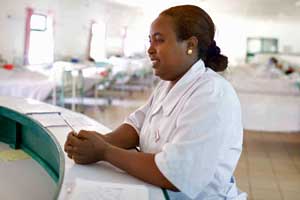Mandatory continuing professional development
There is ongoing debate and inconclusive evidence as to whether mandatory continuing education for relicensure leads to more professional growth and enhanced performance. In a study of continuing education participation in the US, nurses mandated to attend continuing education courses did take significantly more courses than those who were not required to do so. They were also more likely to take courses on topics unrelated to their specialty, simply to meet the requirement (ibid.).
 From another perspective, Ndege (2006) argues that “to further facilitate the development of CPD in Africa, there is a need to give CPD legitimacy by establishing a legal framework for CPD…clear policies and structures to support CPD should be put in place.” Across Africa, countries are at different levels of developing CPD systems. In some countries, such as Uganda and South Africa, regulatory bodies require a specific number of professional development credits or continuing medical education (CME) credits in order to reregister or relicense certain health worker cadres (Ndege 2006). In most African countries, however, there are no systematic approaches to regulating CPD programs, and documentation of CPD completion is not required for relicensure (Muula et al. 2004).
From another perspective, Ndege (2006) argues that “to further facilitate the development of CPD in Africa, there is a need to give CPD legitimacy by establishing a legal framework for CPD…clear policies and structures to support CPD should be put in place.” Across Africa, countries are at different levels of developing CPD systems. In some countries, such as Uganda and South Africa, regulatory bodies require a specific number of professional development credits or continuing medical education (CME) credits in order to reregister or relicense certain health worker cadres (Ndege 2006). In most African countries, however, there are no systematic approaches to regulating CPD programs, and documentation of CPD completion is not required for relicensure (Muula et al. 2004).
Requirements in Asia are likewise diverse. Singapore has required CME for physicians to maintain their licenses since 2005 (van der Velden et al. 2010). Japan has no mandatory system, but the Japan Medical Association conducts a voluntary certifying program. Approximately 70% of its membership is certified (Pelletier 2010). India’s individual states have differing requirements, but none has been in place long enough to evidence compliance (ibid.) Public-sector professionals in Malaysia are required to participate in CPD, but private doctors are not (ibid.). Vietnam, in accordance with an agreement to mutually recognize nurses’ licenses within Association of Southeast Asian Nations (ASEAN) countries, is working to institute an internationally recognized licensing system. In 2009, the Law on Examination and Treatment (LET) called for licenses to be issued to physicians, nurses, midwives, and assistant doctors by 2016. LET includes a requirement that all practitioners participate regularly in CPD, or their license can be revoked. However, LET does not specify the number of hours or types of CPD required (van der Velden et al. 2010). In Southwest Asia, the Abu Dhabi Health Authority in the United Arab Emirates requires physicians to attain at least 50 hours of CME per year for license renewal, of which 25 must be in the form of formal education from either an accredited medical school or a professional body (Younies, Berham, and Smith 2010).
In the European Union (EU), 17 of the member states require CPD for some cadres of health workers, and many of the remaining 10 have guidelines encouraging participation. The number of credits expected of medical practitioners varies widely, from a low in Slovenia of 10.7 credits per year to a high in Bulgaria at 150 (Costa et al. 2010). In keeping with the EU’s cross-border principles, CME attained in two-thirds of EU countries is certified by the European Accreditation Council for Continuing Medical Education. Such credits are acceptable in all affiliated states (ibid.). Garattini et al. (2010) found that compulsory continuing development programs in Austria, France, Italy, and the UK had few or no legal enforcement mechanisms. Austrian physicians noted that they were encouraged to comply with requirements because the likelihood of being subject to litigation increases without such compliance (ibid.). Rather than implementing mandatory CME participation, Belgium and Norway encourage participation through financial incentives. In Belgium, non-hospital physicians receive yearly bonus payments and can ask higher fees per patient when they accumulate 20 credits of CME per year. General practitioners in Norway have no CME requirements, but specialists will lose their specialization (and 20% higher fee) if they fail to participate in specialty-specific CME courses (ibid.).
In Latin America, many policies regarding professional education are guided or provided by professional associations. Argentina’s medical societies have long been responsible for accreditation and provision of CPD, though the country’s medical schools are beginning to involve themselves in the process to a greater degree. In Mexico, a large number of specialty boards require CPD for members to maintain specialty certifications. Moreover, many private-sector hospitals and clinics require physicians in their employ to participate in CPD/CME courses. The Mexican government is considering a compulsory program (Pelletier 2010).

